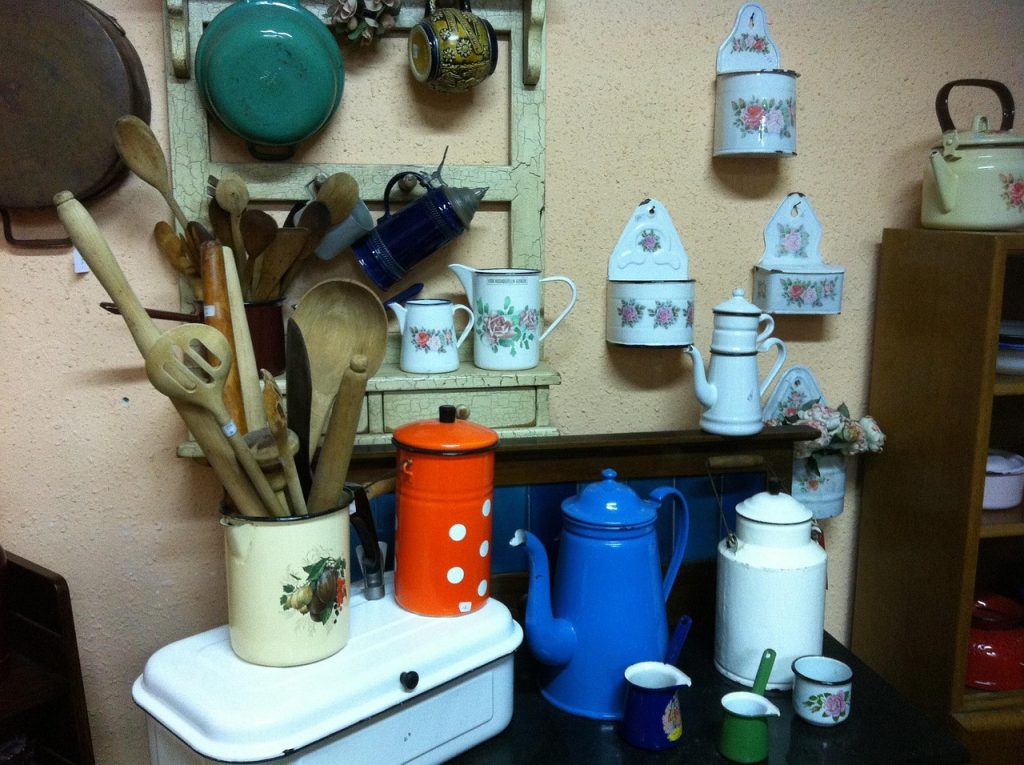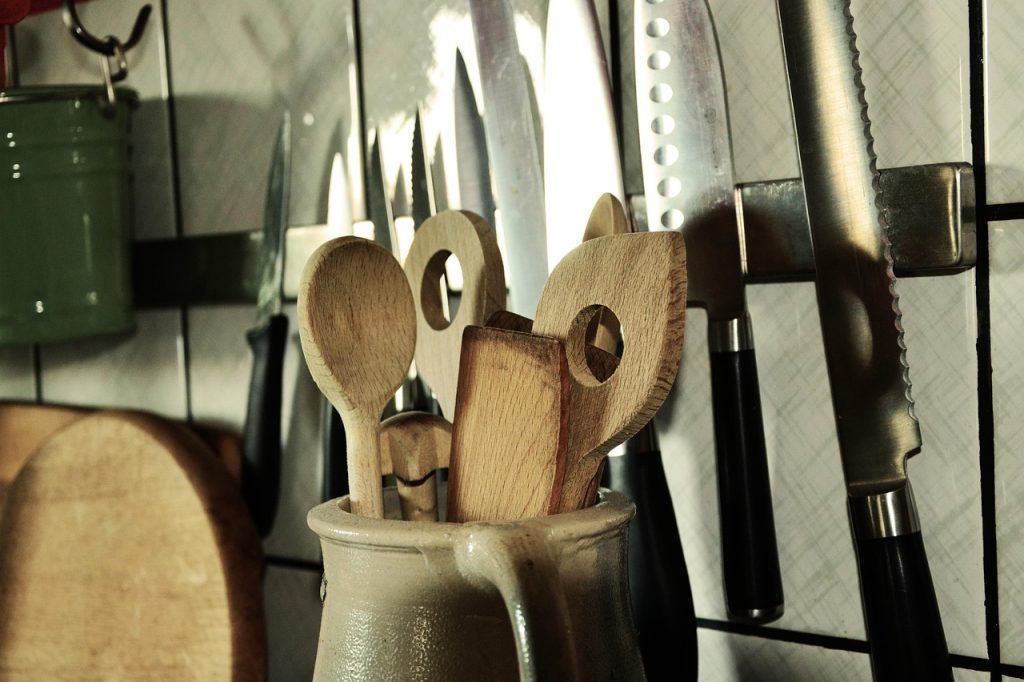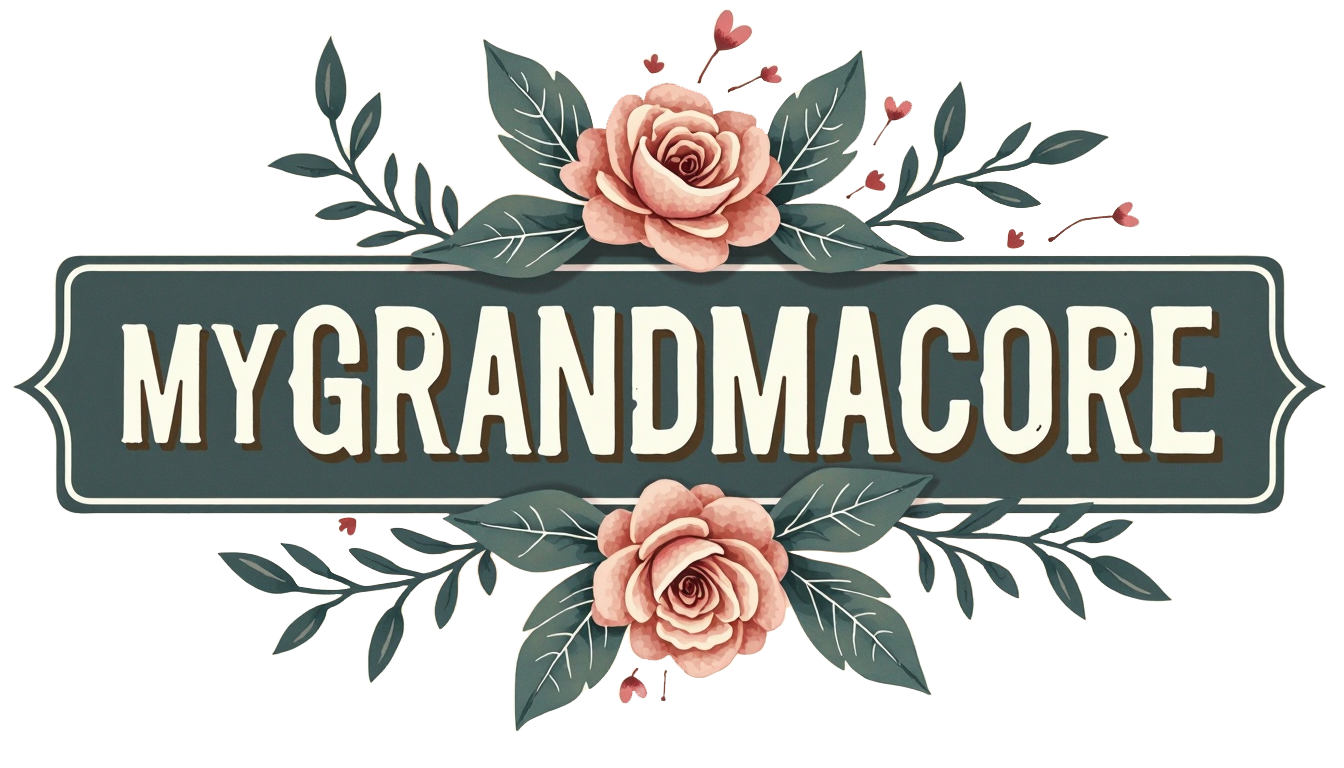Key Takeaways
- Brand, age, condition, and scarcity are the main value drivers for vintage kitchenware
- Cast iron, Pyrex, and enamelware offer the most authentic GrandmaCore aesthetic
- Research completed sales rather than asking prices to determine true market value
- The right care maintains both beauty and financial value
- Focus your collection on pieces you’ll actually use for the most satisfaction
Do you crave the warmth and character of your grandmother’s kitchen? You’re not alone. The GrandmaCore aesthetic has taken the design world by storm, with vintage kitchenware at its heart. But how do you know if that rusty cast iron skillet is worth $10 or $100?
Whether you’re hunting for bargains or sorting through family heirlooms, understanding how to value vintage kitchenware will save you money and help you build an authentic farm-style kitchen. Let’s cut through the confusion and get straight to what matters.
What Makes Vintage Kitchenware Valuable
Stepping into a kitchen filled with vintage treasures feels like traveling back in time. That speckled enamel coffee pot sitting on the stove might remind you of early mornings at grandma’s house, the rich aroma of coffee filling the air while bacon sizzled in a well-seasoned cast iron pan. These pieces carry stories and history that modern replicas simply can’t match.
Not all old kitchen items are created equal. Here’s what determines their worth:
- Age – Generally, items made before 1950 command higher prices, with pre-1900 pieces often being most valuable
- Brand – Certain manufacturers like Griswold (cast iron), Pyrex (glassware), or Hall (ceramics) fetch premium prices
- Condition – Original finishes, minimal wear, and no repairs typically mean higher value
- Scarcity – Limited production runs, discontinued patterns, or rare colors significantly boost value
- Cultural significance – Items that represent important eras or developments in kitchen history carry added value
For example, a Wagner cast iron skillet from the 1930s in good condition might sell for $50-100, while a rare Griswold “spider skillet” from the same era could fetch $500 or more.
Most Valuable Vintage Kitchenware for GrandmaCore Kitchens
Picture this: morning sunlight streams through lace curtains, casting warm patterns across your kitchen counter. Your collection of butter-yellow Pyrex bowls sits proudly on open shelving, while a row of cast iron skillets hangs from hooks on exposed beams. This isn’t just decoration—it’s a functional kitchen filled with tools that have proven their worth for generations.
Focus your collecting efforts on these high-impact categories:
Cast Iron Cookware
The workhorses of farm kitchens, vintage cast iron pieces offer both function and beauty. There’s something magical about cooking in a pan that might have prepared meals during the Great Depression or World War II. The cooking surface, burnished to a satiny finish by years of use, delivers heat more evenly than any modern non-stick pan could dream of.
Look for:
- Griswold and Wagner pieces (pre-1960)
- Smooth cooking surfaces (unlike modern rough-cast versions)
- Unusual shapes or specialized functions (waffle irons, gem pans)
A well-maintained Griswold #8 skillet can sell for $100-200, while rare pieces like a Griswold “slant logo” Dutch oven might fetch $300-500.
Pyrex and Vintage Glassware
Colorful patterns and practical designs make these kitchen staples highly collectible. When you spot a turquoise Butterprint casserole dish or a set of Primary Colors mixing bowls at a thrift store, your heart might skip a beat—and for good reason. These pieces combine mid-century charm with incredible durability. Many have survived daily use for 60+ years and still look vibrant.
Keep an eye out for:
- Colored mixing bowl sets (especially complete sets)
- Pattern-based casserole dishes (Butterprint, Gooseberry, Snowflake)
- Promotional items with original lids
A complete set of Primary Colors mixing bowls typically sells for $80-120, while rare patterns like “Lucky in Love” can command $1,000+.

Enamelware
Durable and colorful, these pieces bring instant farmhouse charm. Just imagine a crisp white enamel basin with a cherry-red rim sitting on your counter, filled with fresh-picked apples from the orchard. Enamelware pieces carry that perfect balance of utility and beauty that defines the GrandmaCore aesthetic. They’ve helped prepare countless meals and withstood decades of use.
Look for:
- Blue or red-rimmed white pieces
- Coffee pots and kettles
- Canisters and storage containers
Mint condition enamelware coffee pots typically range from $40-80, while complete canister sets might fetch $100-150.
Kitchen Utensils and Gadgets
Small items with big character. There’s something wonderfully tactile about wooden-handled whisks and potato mashers that connect you to cooking traditions of the past. These tools were made when things were built to last—when a kitchen gadget was expected to serve multiple generations, not just until the next product cycle.
Hunt for:
- Wooden-handled implements
- Hand-cranked tools (egg beaters, grinders)
- Unusual single-purpose tools
Prices vary widely, from $5-10 for common utensils to $50+ for rare or unusual gadgets in excellent condition.

Ceramics and Stoneware
Sturdy and functional with beautiful glazes. The weight of a substantial yellowware mixing bowl in your hands feels satisfying in a way that modern plastic never could. These pieces developed their character through years of service, mixing countless batches of cookies and bread dough. Their subtle imperfections and marks of use tell stories of family gatherings and holiday preparations.
Seek out:
- Mixing bowls (especially yellowware)
- Crocks and jugs
- Mason Cash or Red Wing pieces
A large vintage yellowware mixing bowl might sell for $60-120, while a 5-gallon stoneware crock in excellent condition could fetch $200-300.
How to Identify Authentic Vintage Pieces
Let’s be honest—the reproduction market is booming, and not every “vintage-looking” piece deserves a spot in your GrandmaCore kitchen. Holding a true vintage piece feels different. There’s a certain heft, a quality of construction that modern manufacturers rarely replicate. Running your fingers over the bottom of an old Pyrex bowl might reveal subtle mold marks that tell you it’s the real deal.
Before assessing value, confirm you’re dealing with true vintage items:
Check for markings:
- Manufacturer stamps or logos
- Patent numbers
- Country of origin
Examine materials and construction:
- Heavier weight than modern counterparts
- Hand-finished details
- Signs of hand assembly
Look for period-appropriate features:
- Pre-1960s Pyrex used borosilicate glass (modern pieces use soda-lime)
- Vintage cast iron has a smoother finish than modern pieces
- Old wooden handles often have a different grain pattern and finish
Step-by-Step Valuation Process
I remember my first flea market find—a Fire-King jade-ite mug that I paid $3 for, only to discover later it was worth closer to $30. That early win got me hooked on the treasure hunt aspect of vintage kitchenware collecting. But not every piece will be a jackpot, and that’s okay. The real value often comes from the joy these items bring to your daily cooking routine.
Follow this reliable method to determine what your kitchenware is worth:
- Clean the item carefully – Remove dirt but not patina
- Document identifying marks – Take clear photos of logos, stamps, and patterns
- Research similar items – Check completed sales on eBay, Etsy, and specialized collector sites
- Assess condition honestly – Note chips, cracks, rust, or repairs
- Compare with current market – Look at 5-10 similar items that have recently sold
- Adjust for local market – Prices may vary by region and selling venue
Condition rating scale:
- Mint: Like new, no damage or wear
- Excellent: Minor wear, no damage
- Good: Shows use but intact and functional
- Fair: Some damage or heavy wear
- Poor: Significant damage affecting function
Where to Find Good Deals on Vintage Kitchenware
There’s nothing quite like the rush of finding a dusty box of pristine Pyrex at the bottom of a garage sale table, marked with a $5 price tag. Those moments make all the early morning hunts worthwhile. The thrill of the chase becomes part of the fun, and each piece in your collection carries not just its own history, but the story of how it came into your hands.
Build your collection without breaking the bank:
- Estate sales – Arrive early for best selection
- Rural thrift stores – Often less picked-over than city locations
- Facebook Marketplace – Look for sellers who don’t specialize in antiques
- Yard sales – Focus on older neighborhoods
- Family connections – Ask relatives if they have unwanted kitchen items
The best deals often come from sellers who don’t recognize the value of what they have. A $5 cast iron pan at a yard sale might be worth ten times that amount.
Caring for Your Vintage Kitchen Collection
Your grandmother’s kitchen tools lasted so long because they were cared for properly. There’s something deeply satisfying about maintaining these pieces—like you’re carrying on a tradition of stewardship. When you season a cast iron pan or carefully hand-wash a Pyrex bowl, you’re participating in rituals that connect you to generations of home cooks who came before you.
Maintain and increase value with proper care:
For cast iron:
- Clean with hot water and stiff brush (no soap)
- Dry thoroughly and apply thin coat of oil
- Store in dry place
For Pyrex and glassware:
- Hand wash only (dishwashers damage patterns)
- Avoid sudden temperature changes
- Store with padding between pieces
For enamelware:
- Wash gently with mild soap
- Avoid abrasive cleaners
- Display away from direct sunlight
Frequently Asked Questions
Should I restore vintage kitchenware? For items you plan to use, light restoration is fine. For investment pieces, original condition typically commands higher prices.
Is vintage kitchenware safe to use? Most items are safe, but check for lead in old ceramic glazes and avoid using damaged Pyrex for hot foods.
What’s the best first piece for a new collector? Start with cast iron skillets or Pyrex mixing bowls—they’re useful, available, and hold their value well.
How can I tell if Pyrex is vintage? Look for borosilicate glass (it doesn’t warp under heat), older patterns, and marks indicating USA origin.
Should I haggle when buying vintage kitchenware? Yes, at flea markets, yard sales, and some antique stores. Research values beforehand so you know what’s fair.
Creating a GrandmaCore kitchen isn’t just about aesthetics—it’s about connecting with a simpler time when things were built to last. Each time you reach for that perfectly seasoned cast iron skillet or mix cake batter in a sunshine-yellow Pyrex bowl, you’re not just using a tool; you’re continuing a tradition. Start your GrandmaCore kitchen transformation today by focusing on quality over quantity. A few well-chosen vintage pieces will add more character than dozens of modern reproductions. Happy hunting!
